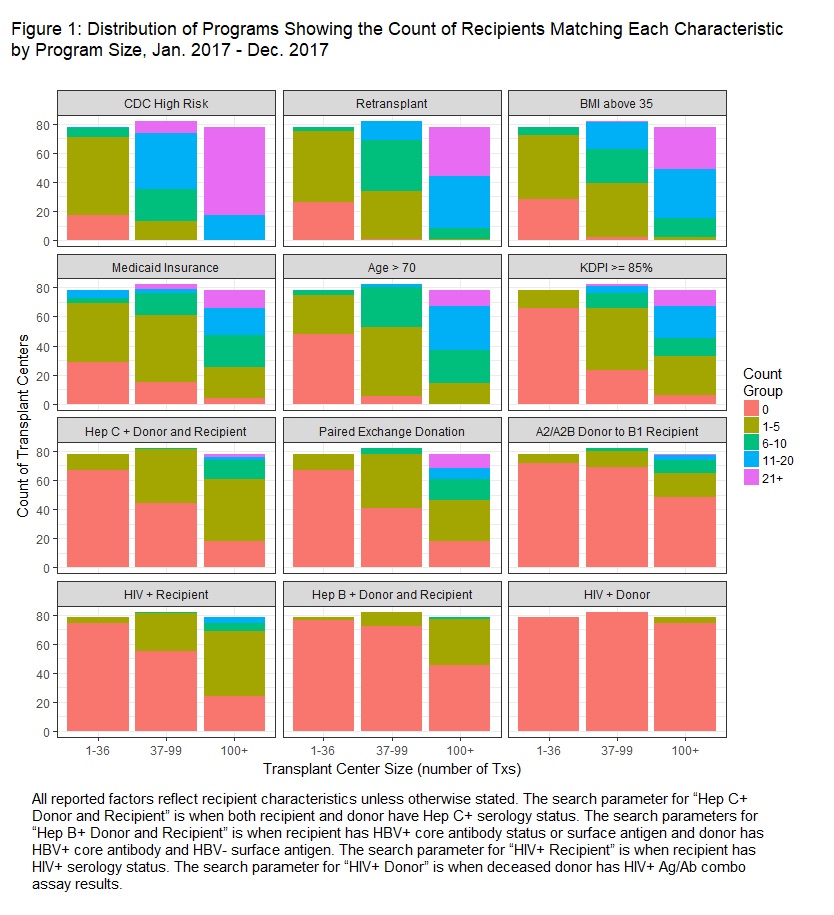Variations in Recipient and Donor Clinical Characteristics between Kidney Transplant Centers
1Nephrology, Hennepin Healthcare Research Institute, Minneapolis, MN, 2College of Design, University of Minnesota, St. Paul, MN, 3Scientific Registry of Transplant Recipients, Hennepin Healthcare Research Institute, Minneapolis, MN, 4Department of Surgery, University of Minnesota, Minneapolis, MN, 5Department of Medicine, Hennepin Healthcare, Minneapolis, MN
Meeting: 2019 American Transplant Congress
Abstract number: D182
Keywords: Kidney, Kidney transplantation, Patient education, Risk factors
Session Information
Session Name: Poster Session D: Non-Organ Specific: Disparities to Outcome and Access to Healthcare
Session Type: Poster Session
Date: Tuesday, June 4, 2019
Session Time: 6:00pm-7:00pm
 Presentation Time: 6:00pm-7:00pm
Presentation Time: 6:00pm-7:00pm
Location: Hall C & D
*Purpose: When a patient can choose at which kidney transplant program to establish care, prior knowledge of program acceptance practices (of candidates and donors) can be valuable and may guide patients to select a center that maximizes access to transplantation.
*Methods: We analyzed kidney recipient and donor data from the Scientific Registry of Transplant Recipients (SRTR) to determine how recipient characteristics (e.g. age, insurance type, BMI) vary between transplant programs. SRTR data included recipients (n=20,637) and donors at each program between Jan. 1, 2017 and Dec. 31, 2017. In order to account for differences in program volume the distribution of recipient characteristics was plotted and grouped into small (1-36 transplants/year), medium (37-99 transplants/year), and large (100+ transplants/year) sized programs. Kidney transplant volume by characteristic can range from 0 to greater than 21.
*Results: In the US, recipient and donor characteristics vary across programs, however, not all variability can be attributed to program size. Several recipient characteristics (e.g. Hepatitis C+ serology status, Age>70, Retransplant, BMI>35) reflect variations between each class of program size. At the same time, recipient characteristics like A2/A2B to B blood type and donor characteristics like HIV+ remain steady across differently sized programs and are in fact, rarely performed by most transplant programs.
*Conclusions: Acceptance criteria for entry onto the kidney transplant waitlist vary by program and access to transplantation and patient mortality may be influenced by variations in acceptance criteria. Further examination of recipient data and program volume is required to evaluate the statistical significance of program volume on waitlist acceptance practices and transplantation. If robust, incorporating measures that capture transplant volume and recipient characteristics into resources for patients may improve access to transplantation and the likelihood of receiving care at a program with recent experience transplanting patients like them.
To cite this abstract in AMA style:
McKinney WT, Bruin M, Chu S, Schladt D, Snyder J, Matas A, Kasiske B, Israni AK. Variations in Recipient and Donor Clinical Characteristics between Kidney Transplant Centers [abstract]. Am J Transplant. 2019; 19 (suppl 3). https://atcmeetingabstracts.com/abstract/variations-in-recipient-and-donor-clinical-characteristics-between-kidney-transplant-centers/. Accessed December 13, 2025.« Back to 2019 American Transplant Congress

